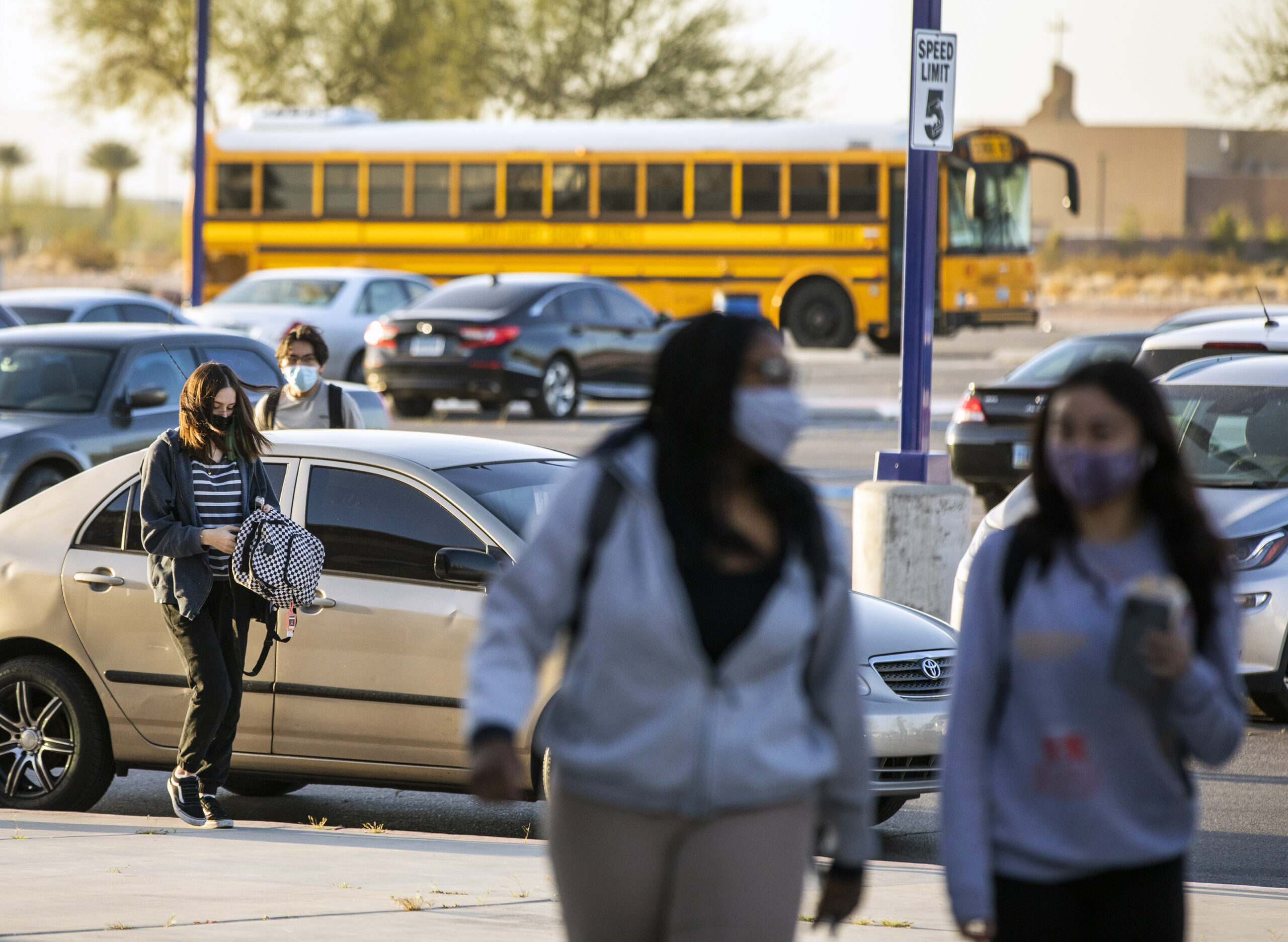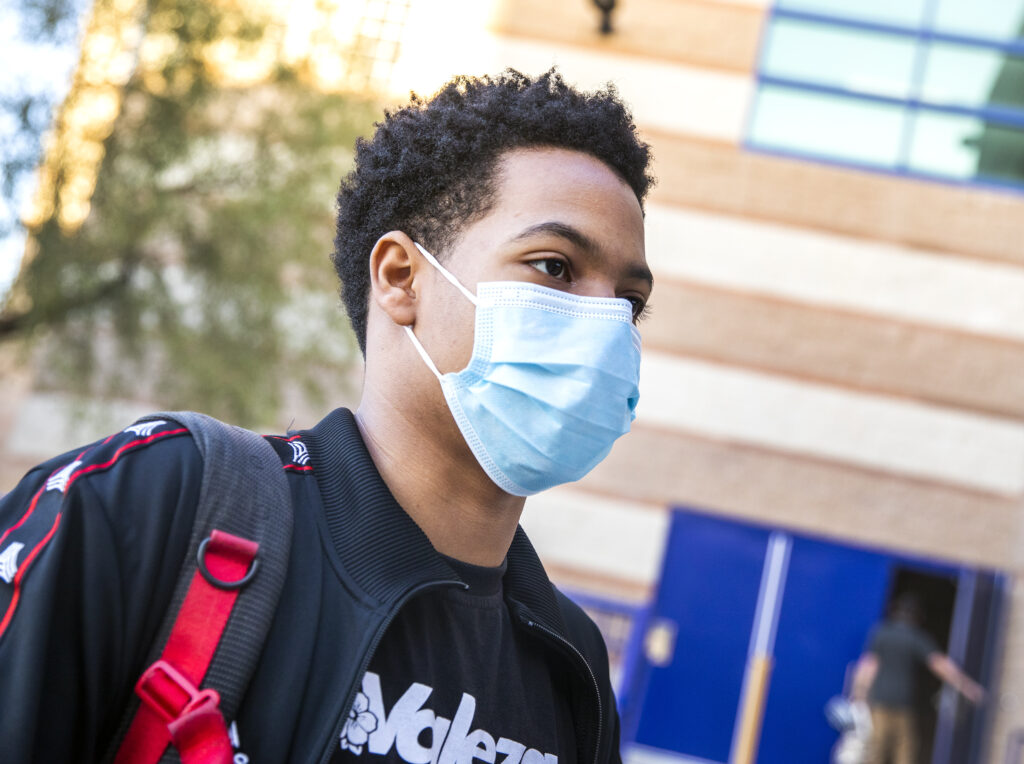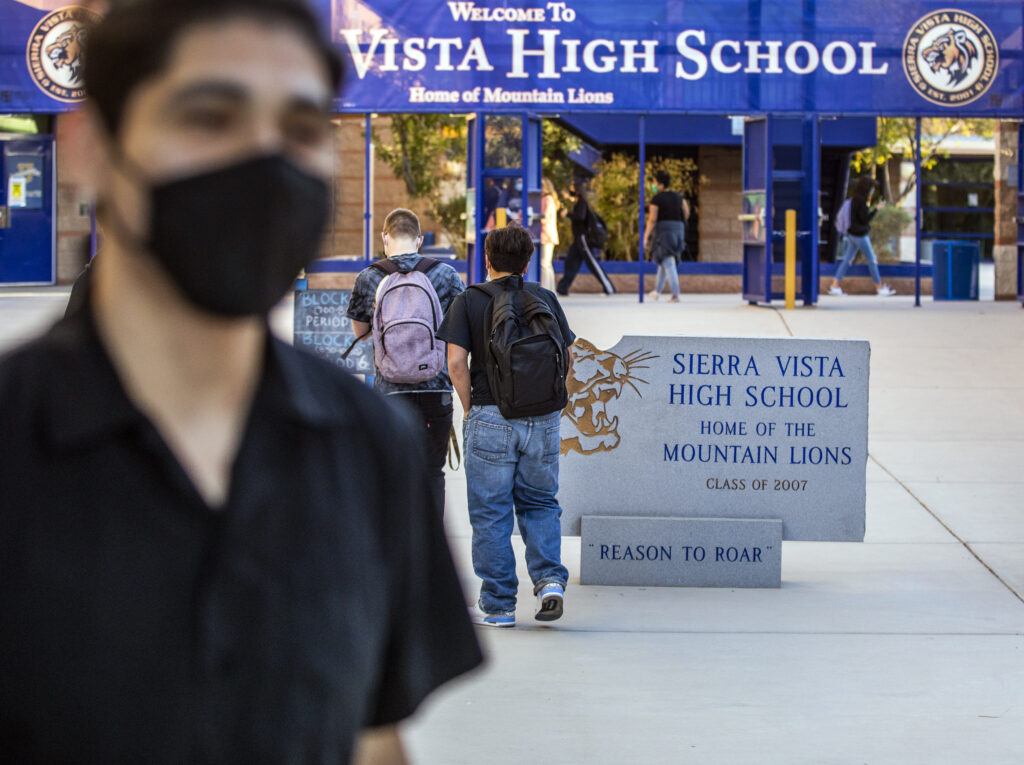In Clark County, fewer older students opt for in-person learning

After more than a year learning from home, 17-year-old Donovan Scurry couldn’t sleep Monday night, distracted by the change in routine the next day would bring.
Tuesday was his first day back in person at Sierra Vista High School in Las Vegas. Scurry arrived shortly before 7 a.m., donning a backpack and face mask as he entered familiar turf for the remaining weeks of his junior year. This was his choice, a decision prompted by dwindling grades and lackluster motivation for distance education.
“I just missed the environment,” he said. “And even though coming back is going to be different with COVID and stuff, I just feel like the environment is still what I am used to and what I need.”
The school entrance didn’t contain the normal hustle and bustle associated with morning arrivals. Students trickled in, some in small groups, as the sun grew brighter and the start of classes creeped closer. Of the high school’s roughly 2,800 students, only 480 chose the in-person hybrid option. Because the in-person cohorts rotate days, half that number — roughly 240 students — are on campus Monday, Tuesday, Thursday and Friday. Wednesday is a remote education day for all students.
Unlike Scurry, the vast majority of students opted to remain in distance-education mode for the rest of the school year. Sierra Vista High School’s numbers reflect the Clark County School District at large, which has seen stronger enthusiasm for in-person learning among elementary students. In March, the district began gradually reopening schools, starting with the youngest children, but as of Tuesday, all students have the option of at least some in-person learning. Elementary schools are providing face-to-face instruction five days a week, while middle and high schools are operating under a hybrid model.
More than half of elementary students — 56 percent — have returned to school campuses, according to school district data, but that percentage shrinks considerably for the upper grades. Districtwide, only 36 percent of students in middle and high school chose the in-person hybrid model.


John Anzalone, principal of Sierra Vista High School, chalked it up to several factors. Many students have picked up jobs and may not want to alter their schedules. Some still fear catching COVID-19 or spreading it to family members, especially because vaccines aren’t available for people younger than 16 years old. Additionally, it’s not the same in-person experience: Students only attend school in person two days a week, and those days consist of two 100-minute classes. There are no assemblies or socialization time in the quad.
“To a lot of kids, that’s not fun,” he said. “If I’m 16 years old, I’m probably thinking the same thing.”
Janai Tillman, a senior at Sierra Vista, remembers feeling nervous when students learned they would not be returning to school buildings in August. She asked her mother, who works from home, for tips to stay focused. The 17-year-old started by setting a wake-up time — usually 7 a.m. — and quickly realized she could get her school work done early in the day. Now, she works at a restaurant in the afternoon and plays volleyball in the evening.
Reconstructing her schedule this far into the school year seemed like a hassle.
“I didn’t want to mess up that routine I already had,” she said.
Angelina Ford, a junior at Sierra Vista, opted to stay home, too. She said her friends who returned to school mostly did so because of clubs or sports. So rather than rush to school for a few hours twice a week, Ford’s days usually start like this: She wakes up and rolls to the other side of the bed, careful not to wake her sleeping cat and dog, before flipping on her iPad. Eventually, she will grab something to eat and perhaps move outside to do some reading.
Ford, whose mother is Clark County School Board Trustee Danielle Ford, didn’t gloss over the difficulties of online learning. Math has been a challenge, she said, but the 16-year-old remained optimistic about catching up academically next year.
“I think it’s going to be the same for everyone, so it’s not like I’m the only one behind,” she said. “It will be like a group effort — we’re all behind so let’s do it together.”
While in-person enrollment is generally lower in the upper grades, the numbers vary by school. The school district has not released information for individual schools, but several principals shared their numbers with The Nevada Independent. At Shadow Ridge High School, 40 percent of students chose the in-person hybrid model. Rancho High School, Spring Valley High School and West Prep Academy, meanwhile, saw only about a third of their ninth- through 12th-grade students return.
But about 58 percent of students at Boulder City High School chose the hybrid instructional model. The interest was particularly strong among freshmen — 72 percent returned.

“At least it’s a step,” Spring Valley High School Principal Tam Larnerd said, referring to the hybrid model. “It’s not ideal, and it’s not what any of us want for our kids, but it’s a step in the right direction.”
Clark County Superintendent Jesus Jara has signaled an intent to bring all students back full time for the 2021-2022 school year, while offering distance education as an option. No plans have been formally announced, but Anzalone said high schools are already brainstorming how to make it work. For instance, what happens if only two students want to take an Advanced Placement Calculus course online?
“It’s going to be complicated, but in reality, we know it’s coming,” he said. “We know high school is never going to look the same.”
High school students have already come to that same conclusion. Macy Beck decided to finish her senior year at Sierra Vista High School in person. Beck said her government class only has three students attending in person, which has allowed for in-depth discussions and time to bond with each other. But that silver lining, she said, doesn’t make up for all the other losses students suffered this year. They missed sports and yearly traditions. They couldn’t get to know their teachers as easily or see friends on a daily basis.
Instead, Beck said the year seemed filled with excusing coming down from the district about why schools couldn’t reopen sooner.
“I wasn’t happy, and I felt like our school district wasn’t doing much to help that,” she said. “And now I feel like we were kind of thrown a little bone with going back to school, but we still don’t get a lot of the things that make high school what high school is.”
